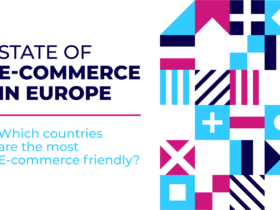One of the fastest growing e-commerce markets in the world might surprise you. The MENA e-commerce market is growing at an unprecedented rate, and opening up a whole new set of questions and challenges for those looking to get
into this market.
MENA is an acronym which stands for the region of the Middle East & North Africa. The list of countries included in the MENA region can differ depending on who you are talking to:
- Morocco
- Oman
- Qatar
- Algeria
- Bahrain
- Egypt
- Islamic Republic of Iran
- Saudi Arabia
- State of Palestine
- Iraq
- Israel
- Jordan
- Kuwait
- Lebanon
- Libya
- Syrian Arab Republic
- Tunisia
- United Arab Emirates (UAE)
- Yemen
These countries are typically throughout the Middle East and North & West Africa. The MENA e-commerce market faces intense growth as its population of about 315 million people gradually get online.
MENA E-commerce Market: Growth and Development
For the last 5 years, number of internet users has been rapidly growing in the MENA region. For instance, countries like Qatar, Bahrain and the UAE current internet penetration rate represents more than 90%. Not every MENA country gets such interesting figures and they often have less internet penetration. Even though the internet penetration increases and the technology enables people to shop online, it doesn’t mean they will actually do it. However, E-commerce is on the rise in these countries as users become more familiar with online purchasing.
As more people shop online, e-commerce has started to change the way brands interact with people in the region. On this matter, research shows that year-to-year e-commerce growth in Middle-East reached 30%. This means that there are numerous markets are still to conquer. Some countries like the UAE, Saudi Arabia and Egypt already experiment some great innovation and might become part of the fastest growing e-commerce markets in the world over the next few years.
Concerning the retail, the MENA population loves to shop, as you can see in the number of souqs (or markets), most of them being historical. This business is well organized but experts predict e-commerce is going to become more important. This is true for both developed and less developed parts of the region. Especially because less developed areas are where people are the most eager to find lower prices and more purchasing convenience. In fact, research shows that consumer electronics are bringing more new customers into online shopping than any other category of goods. Also, categories like fashion and lifestyle products show a buying pattern where customer come back the more often.
If we look at UAE and Saudi Arabia, two reasonably economically developed countries in the region, their smartphone penetration rate is about 70% and half of consumers are likely to shop online via their mobiles. While this penetration for mobile shopping hasn’t yet reached every corner of the MENA e-commerce market, the climate is perfect for these developments.
In Egypt, like in the rest of the region, mobile phones have outnumbered the use of landlines. This penetration will allow the MENA e-commerce market to go a step further. For example, as surprising as it sounds, Egypt is now one of Uber’s most important markets.
To make it more concrete, let’s take a look at the situation in the UAE, one of the e-commerce leaders in the MENA region.
Practical case: The United Arab Emirates
Hootsuite and We Are Social found out some interesting figures in their last research. In the United Arab Emirates, the number of internet users is as high as 99%. On a year-on-year basis, online shoppers represent now 62%, which is 25% more than last year. Research also demonstrates that, on the same period, 47% of them used their smartphone to complete those online purchase.
Other research from Network International shows that more than 30% UAE citizens usually shop online 1 to 5 times per week. Despite the current effect of oil prices falling, consumer spending power continues to grow.
Like in the rest of the world, this internet and mobile penetration leads to the development of e-commerce as well as social commerce. For their part, Qatar and the UAE, are the countries of the world counting the highest rate of social media penetration reaching nearly 99% of use within their populations. Digital use in the Middle East is on the rise, and it is not a surprise as it is the case worldwide. But people usually don’t realize how huge m-commerce already is in some MENA’s countries, nor it’s potential for growth.
The KPMG survey studied consumer behavior and found out that UAE residents spend an average of $332 per online purchase. This amount is quite important and they take the time for reflection before they decide to buy. Once the decision has been made, however, the cart amount is high.
The categories those online shoppers most often purchase consist of electronics, apparel, accessories, and perfumes. The UAE is one of the most economically active countries in the MENA e-commerce market. Experts like Haritha Ramachandran, think this market will grow to reach $10 billion by 2018. The UAE will probably set the path for the rest of the region, which means platforms like Souq, one of the leaders in the MENA e-commerce market, should not have any worry the future.
Virtual Info System launched a survey demonstrating that even if 23.6% of the UAE population now prefers shopping online, 76.4% of them prefer to shop at their usual brick-and-mortar stores. Also, in a country where cash-on-delivery stays the most popular payment methods, online payment services had to come with innovation to garner interest. In order to follow the e-commerce development in the country, CASHU has launched a prepaid card specially designed for online purposes.
CASHU is one the leader when it comes to online payment in MENA. The secure online payment method was created in 2002 and is now used by 2.3 million consumers to pay online. The firm created a new way of shopping online that allows its users to get to any of the 75,000 convenient sellers that exist in the MENA region to credit their account. This way, any UAE residents and other online shoppers from partners countries will be able to create their virtual prepaid card and pay on partner websites.
Like in any other country, deals and discounts influence online buying decisions. The convenience of shopping from home whenever they want and new online payment options are also reasons why UAE residents shop more and more online. The whole MENA region is following that growing trend.
MENA’s E-commerce main players:
Souq.com
Founded in 2005, Souq is the market leader in Middle East region. Based in Dubaï, it is sometimes compared as a regional Amazon. The platform proposes over 1.5 million products to online customers in the UAE, Egypt, Kuwait and Saudi Arabia. It also ships parcels to Qatar, Bahrain, Oman, Jordan and Lebanon. The clever solution (and part of its success ) implemented by Souq is the use of prepaid cards to buy their products, to compensate the fact that not everyone in those countries have access to credit cards to pay online.
In 2016, Amazon started negotiations with Souq in order to acquire the platform and develop its presence in MENA area. But Amazon recently declined the offer over price matter. Souq declared that it will keep growing, though the region’s economy is slowing down with the decline of oil prices, which provokes consumers to search for better deals.
Noon.com
Noon.com is a new regional marketplace which is about to be launched, presenting about 20 million products. Created by businessman and billionaire Mohamed Alabbar, the new platform will sell all sorts of products and benefit from same day delivery operated by Noon Transportation. As he recently declared, Alabbar wants to “[turn the] e-commerce environment in the region upside down.” Even though the objective is to expand in the future, it will operate in Saudi Arabia and UAE at first. The activity should start in Egypt by the end of 2017 / early 2018. Noon will have its own online payment system available to customers called NoonPay, and a logistics centre in the Dubai World Central.
Others
Some of the principal e-commerce competitors in MENA are Menakart, Jadopado, Letstango, Jumia and Crazydeals for the general retail category. For fashion, you can find websites like Namshi or Sivvi, and for mothers, Mumzworld is the reference for baby & child categories. Most of those e-commerce websites are principally selling to the UAE, Saudi Arabia, Oman, Bahrain, Kuwait and Qatar. Following the worldwide pattern, more and more brick-and-mortar retailers are also going online and contribute to the digitalization of the area.
Several countries constitute MENA region and the majority of their population is Muslim. That being said, the Muslim calendar affects e-commerce in several ways, let’s see how.
MENA E-Commerce Market and Cultural Peculiarity
Most countries included in the MENA’s region have a majority of Muslim population, therefore you need to know what this implies.
Ramadan calendar effects on e-commerce
Each year Muslim celebrates Ramadan. The festive period last for several weeks and includes some schedule adjustment. Research from Souq.com shows that since working hours are reduced to fit the religious schedule, consumers are more likely to spend time shopping online. Time of the day also has an impact on e-commerce during Ramadan. Last year, the UAE’s online traffic increased between 11am and 4pm meanwhile the peak activity in Saudi Arabia increased from 9pm to 4am and 2pm to 4pm.
The seasonal demand for e-commerce is very high as people also look for presents they can give to their family and friends for Eid Al Fitr, the last day of Ramadan. Food demand also increase during that period. Apparently, dates, laban, and yogurt consumption increase the most during Ramadan period. With such rise in activity during Ramadan, this is a good period to propose seasonal sales. For example, online customers in UAE spent 24% more during Ramadan last year, and Saudi Arabian rates got a 15% rise. There is no reason for figures to slow down this year. If your e-commerce operates in the MENA area you still have plenty of time to get ready since ramadan 2017 will start around May 27th.
The Last-mile Delivery Gender Dilemma
The list of countries in the MENA e-commerce market is long. Even though they share some common cultural aspects, some of them have more specification than others. Understand the culture of the market in which you want to operate your e-commerce is crucial. The so important last-mile delivery process can then face some troubles. The use of cash-on-delivery is still very important even with the development of online payment as we’ve discussed. But yet another factor is complicating the delivery process.
In countries where cultural regulation based on gender exist, interaction between unrelated men and women are prohibited. This is the case in Saudi Arabia, for example, women usually won’t open the door for the delivery guy. Not only will the customer not receive the parcel, but the transaction won’t be completed either if payed by cash-on-delivery. Some delivery companies have found the way to bypass these difficulties by employing delivery women. Even if Saudi women can’t drive, they can still knock on the doors to ensure the delivery for female customers.
The MENA e-commerce market is undoubtedly a growing opportunity. Internet and mobile penetration is already on the rise, showing no signs of slowing down. Like everywhere else, customers go online because they know they can find convenience, lower prices, and a wider variety of products. The MENA e-commerce market’s Muslim culture makes it special. With the right strategy, you could find this market to be a great opportunity as well.
Image credit : Mostafa Abd Elsattar







